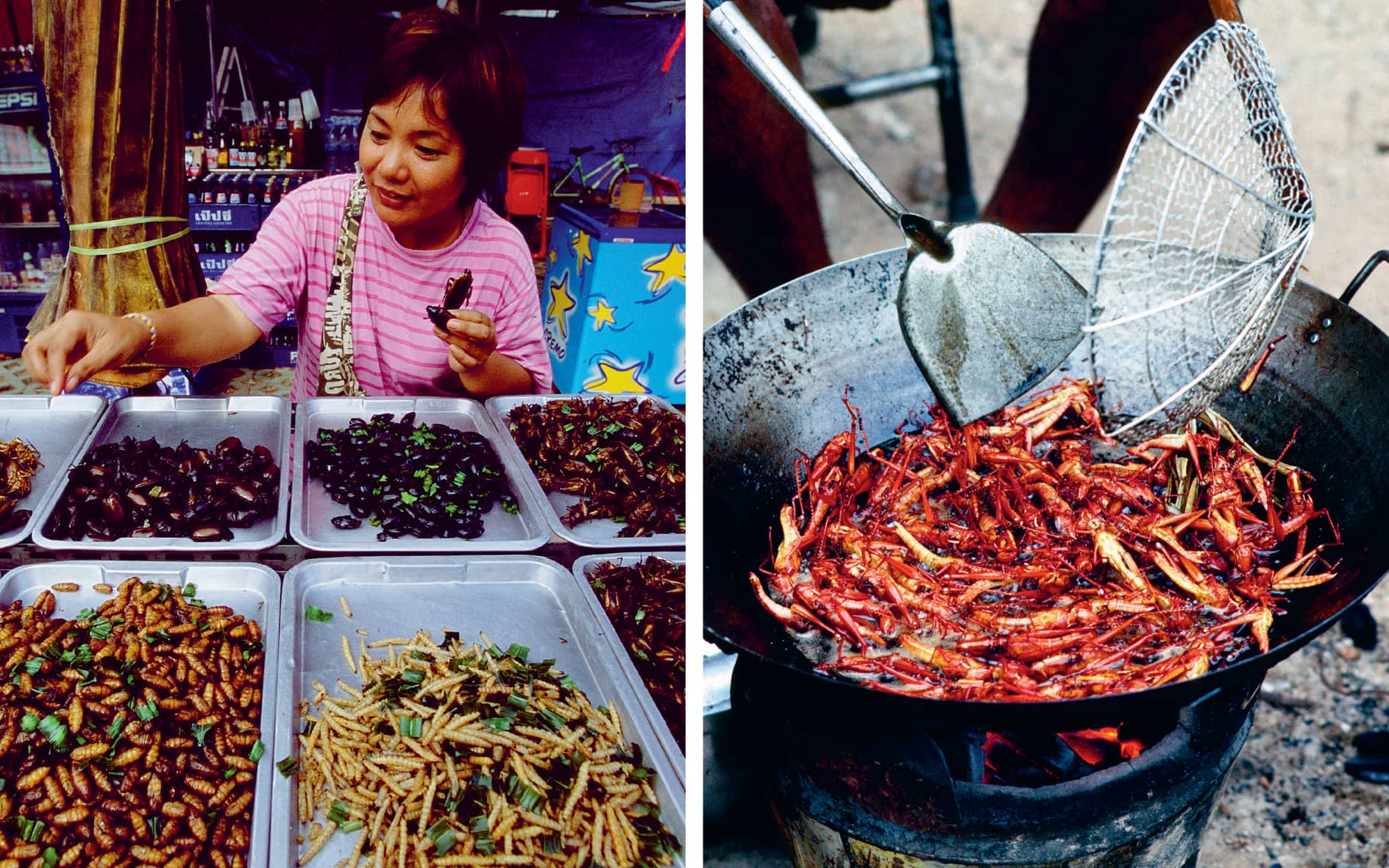What is entomophagy?
Entomophagy is derived from the Greek words ‘entomon’ (insect) and ‘phagein’ (to devour) – and the fact that it has its own term gives some indication of the importance and history of entomophagy. Cave paintings found in Spain dating from 30,000 to 9,000 BC show edible insects and their larvae, while early Biblical examples include John the Baptist surviving on a diet of honey and locusts.
Left: Cambodian street vendors sort crickets (caught by farmers from Kampong Thom province) ready for sale at a market in Phum Thun Mong, Cambodia. Right: Fried insects at a market in Chiang Mai, Thailand
Basically, eating insects isn’t a new phenomenon or novelty fad. In fact, insects are today commonly eaten in 80% of the world’s nations. Roughly 2 billion people worldwide eat insects regularly – that means someone, somewhere is tucking into a tasty insect snack right now.
There are more than 1,900 species of insect that have been identified as edible to humans, but there are bound to be thousands more that we just haven’t got around to trying yet. The most commonly eaten insects are crickets, grasshoppers, ants, beetles (and their larvae such as mealworms and buffalo worms), and several species of caterpillars (including mopani and bamboo worms).
Before setting up our edible insect company Grub, I went travelling around the world in search of traditional insect cuisine, and did plenty of research on insect-eating nations. I wanted to know who eats insects, which insects they eat, how they cook them and how they perceive them as part of their national cuisine. My journey took me to many remote and interesting places with cultures that have been embracing insect-eating for centuries, millennia even.
I discovered that in Mexico, ‘chapulines’ (grasshoppers) are an extremely popular ingredient, especially in Oaxaca City where they’re fried (often with chilli) and eaten as an everyday snack by adults and children alike. In Japan, a favourite is the zazamushi (which literally translates to ‘insect that lives at the bottom of a river’); it’s cooked in sweet soy sauce and served with sake. And in southern African countries, mopani worms can demand a higher price (gram for gram) than beef. In Bali I ate boiled dragonflies in coconut milk with rice (cooked this way, they have a similar texture and taste to soft-shell crab). And in Thailand I visited a school where, during their lunch break, children caught crickets in UV traps set up around the grounds. They’d then keep them to be cooked with pandanus leaves and pepper as a mid-afternoon snack.
My strangest eating experience had to be in Cambodia in a town called Skuon. This place is famous for its tarantula population and a human population that like to catch and eat them (I’m aware that spiders aren’t insects, but they tend to be categorised within entomophagy). The hunting technique is ancient and is still preserved today: a homemade fishing rod (string on a stick) with honeycomb at the end is dangled down tarantula holes. When the spider bites the honey it becomes stuck and can be lifted out. The hunting is usually done by young children who then sell the spiders at the market for pocket money. I admit to a mild case of arachnophobia, so I was dreading the experience of tucking into them as a meal. But I boldly bought a few beers and tray of roasted tarantulas from the local market to share with my hosts – when I saw them devour them with a dipping chilli sauce, I was encouraged. I thought the legs tasted nice (a little like the crispy bit of a chicken wing), but I struggled with the bloated abdomen which had the texture, not the taste, of a profiterole. It sagged and then a bitter cream oozed out – it was the part the locals enjoyed the most.
The fact that this tarantula abdomen was the locals’ favourite bit is quite revealing. One of the questions sceptics like to ask is: why eat insects in the West when we have affordable meat? This is making the assumption that people only eat insects because they can’t afford pork, beef or chicken. In reality, insects (or tarantula abdomens) are often seen as a treat and a delicacy in these countries, not a food eaten out of necessity. It is simply a learned behaviour to eat (or not to eat) insects.
The eating experiences I had abroad are just a few of the many ways in which insects are enjoyed by different cultures around the world today, some of which Grub believes can be easily adopted by our own culture here in the West. Probably not the tarantulas, though – at least not just yet.
We certainly hope that by making insects easy to buy (and taking the fear out of knowing whether they’re suitable for human consumption), Grub is able to encourage people to try edible insects and experiment with them in everyday cooking. If you want to give it a go, see www.eatgrub.co.uk to buy insects, or see this page for more on farming and sourcing insects.

